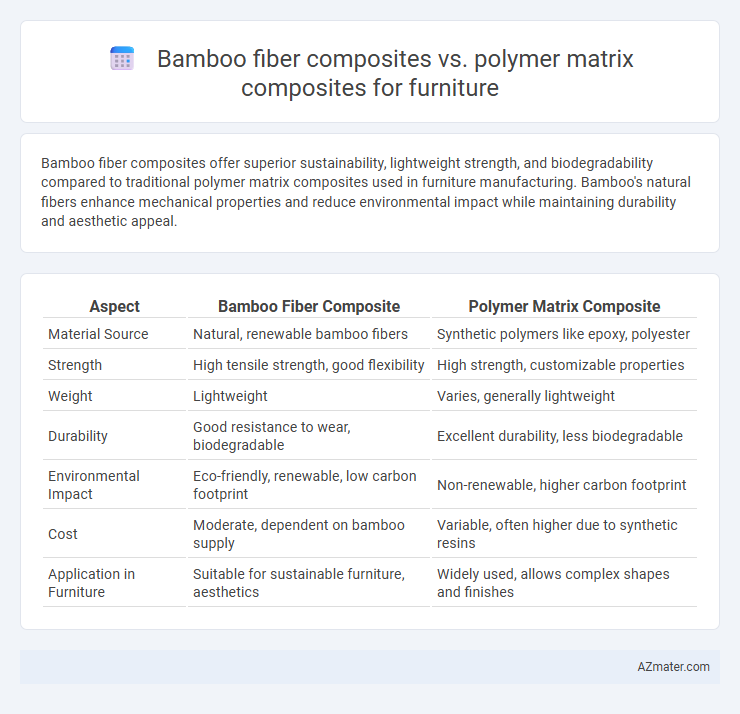Bamboo fiber composites offer superior sustainability, lightweight strength, and biodegradability compared to traditional polymer matrix composites used in furniture manufacturing. Bamboo's natural fibers enhance mechanical properties and reduce environmental impact while maintaining durability and aesthetic appeal.
Table of Comparison
| Aspect | Bamboo Fiber Composite | Polymer Matrix Composite |
|---|---|---|
| Material Source | Natural, renewable bamboo fibers | Synthetic polymers like epoxy, polyester |
| Strength | High tensile strength, good flexibility | High strength, customizable properties |
| Weight | Lightweight | Varies, generally lightweight |
| Durability | Good resistance to wear, biodegradable | Excellent durability, less biodegradable |
| Environmental Impact | Eco-friendly, renewable, low carbon footprint | Non-renewable, higher carbon footprint |
| Cost | Moderate, dependent on bamboo supply | Variable, often higher due to synthetic resins |
| Application in Furniture | Suitable for sustainable furniture, aesthetics | Widely used, allows complex shapes and finishes |
Introduction to Bamboo Fiber and Polymer Matrix Composites
Bamboo fiber composites are gaining attention in furniture manufacturing due to their sustainable nature, high strength-to-weight ratio, and natural aesthetic appeal. Polymer matrix composites consist of synthetic polymers combined with reinforcement fibers, offering superior durability, weather resistance, and design flexibility for various furniture applications. The integration of bamboo fibers within polymer matrices enhances mechanical properties while reducing environmental impact compared to traditional wood and synthetic materials.
Material Composition and Structure Comparison
Bamboo fiber composite consists of natural bamboo fibers embedded in a bio-based resin matrix, offering high tensile strength and eco-friendly biodegradability, while polymer matrix composites use synthetic fibers like carbon or glass within thermoset or thermoplastic polymers, providing superior durability and resistance to moisture. The hierarchical, fibrous structure of bamboo enhances mechanical flexibility and lightweight properties, contrasting with the engineered, uniform fiber orientation in polymer composites that delivers consistent load-bearing capacity. Both materials exhibit unique material compositions and microstructures that influence their suitability for sustainable and high-performance furniture applications.
Mechanical Properties: Strength and Durability
Bamboo fiber composites exhibit excellent tensile strength and impact resistance, making them highly durable for furniture applications while offering greater eco-friendliness compared to polymer matrix composites. Polymer matrix composites provide superior stiffness and thermal stability but often lack the biodegradability and natural resilience found in bamboo fiber composites. The mechanical properties of bamboo fiber composites, including high specific strength and fatigue resistance, make them a sustainable alternative to traditional polymer matrix composites in furniture manufacturing.
Environmental Impact and Sustainability Analysis
Bamboo fiber composites significantly reduce environmental impact due to their renewable nature, rapid growth cycle, and biodegradability compared to conventional polymer matrix composites derived from non-renewable petroleum resources. The carbon sequestration capability of bamboo fibers during their growth phase contributes to a lower overall carbon footprint, enhancing sustainability in furniture applications. Polymer matrix composites often involve energy-intensive manufacturing processes and present end-of-life challenges, while bamboo fiber composites facilitate easier recycling and composting, aligning with circular economy principles.
Manufacturing Processes and Techniques
Bamboo fiber composite manufacturing involves processes like pultrusion, compression molding, and resin impregnation, emphasizing sustainable sourcing and biodegradability. Polymer matrix composites (PMCs) typically employ techniques such as hand lay-up, spray-up, filament winding, and resin transfer molding, focusing on high strength-to-weight ratios and versatility in design. Bamboo fiber composites offer eco-friendly alternatives with renewable raw materials, while PMCs provide superior mechanical properties and consistency through well-established industrial methods.
Cost Efficiency and Market Availability
Bamboo fiber composites offer superior cost efficiency compared to polymer matrix composites due to the low raw material cost and rapid renewability of bamboo, which reduces overall production expenses. Market availability of bamboo fiber composites is increasing in sustainable furniture sectors, driven by growing demand for eco-friendly materials, whereas polymer matrix composites dominate mainstream furniture markets with greater industrial-scale production and established supply chains. The choice between these materials depends heavily on budget constraints and consumer preference for sustainability versus traditional durability.
Design Flexibility and Aesthetic Versatility
Bamboo fiber composites offer superior design flexibility due to their natural cellulose fiber structure, allowing intricate shapes and smooth finishes that enhance aesthetic versatility for modern furniture designs. Polymer matrix composites provide high customization in texture and coloration, supporting vibrant and diverse aesthetic options while maintaining structural integrity. Combining bamboo fibers with polymer matrices can optimize both properties, resulting in lightweight, durable furniture with expanded design possibilities and appealing visual effects.
Performance in Furniture Applications
Bamboo fiber composites offer superior sustainability, high tensile strength, and enhanced flexibility, making them ideal for lightweight and eco-friendly furniture applications. Polymer matrix composites provide excellent durability, chemical resistance, and impact resistance, ensuring long-lasting performance in demanding furniture environments. The choice depends on balancing environmental considerations with mechanical requirements for specific furniture designs.
Maintenance, Longevity, and End-of-Life Disposal
Bamboo fiber composites offer superior biodegradability and easier recycling compared to traditional polymer matrix composites, making end-of-life disposal more environmentally friendly. Maintenance of bamboo fiber composites requires attention to moisture control to prevent degradation, while polymer matrix composites resist weathering and corrosion but may require specialized repair techniques. Longevity in polymer matrix composites generally surpasses bamboo fibers due to enhanced durability and resistance to environmental stressors, yet bamboo composites provide a sustainable alternative with acceptable lifespan in indoor furniture applications.
Future Trends and Innovations in Furniture Composites
Bamboo fiber composites are emerging as sustainable alternatives to traditional polymer matrix composites in furniture manufacturing due to their biodegradability, low carbon footprint, and natural aesthetic appeal. Innovations focus on enhancing the mechanical properties of bamboo composites through hybridization with polymers and nanomaterials, improving durability and moisture resistance. Future trends include the integration of smart sensors and eco-friendly resin systems to create adaptive, high-performance furniture solutions that align with circular economy principles.

Infographic: Bamboo fiber composite vs Polymer matrix composite for Furniture
 azmater.com
azmater.com